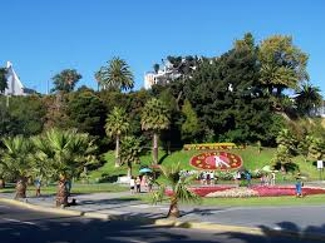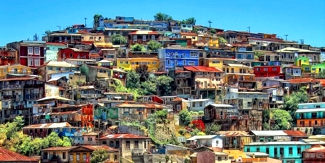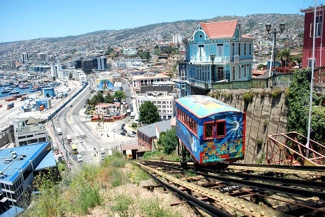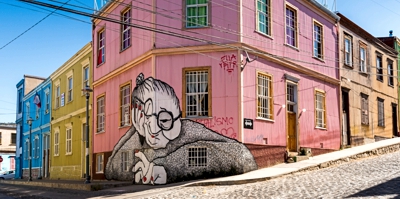

Destinations
Experiences
 |
L A
D A T C O T O U R
S |
 |
||||||||
| HOME | South America | Falkland Islands | Antarctica | Unique Destinations |
Unique Experiences |
Newsstand | ||||
|
Information |
|
 |
 |
 |
 |
VALPARAISO - courtesy of SERNATUR Chile:
At 120 km west of Santiago, Valparaiso is a unique city that not even a town planner could ever have imagined.
Its 45 hills give shape to a natural amphitheater looking to the port and the ocean, while in its narrow plateau next to the sea some streets run parallel to the coastline and others go up and down, zigzagging amidst its ravines.
A swarm of narrow alleyways, long stairways footpaths, viewpoints and houses that seem like they are going to fall into emptiness… which can be accessed by an old funicular railway that goes up and down the sloped hills, and cracks between walls with the sea bottom… that appear and disappear …, these are images of a city that looks up at itself from downtown and of viewpoints and terraces with restaurants that resist the law of gravityThis picturesque, distinctive and multiphasetic Valparaiso awaits its visitors, to explore the most hidden and captivating corners of its entangled city planning.
A number of restaurants, cafés, pubs and hostels have been located on the hills that surround the city center which receive tourists.
In the center, the improvement of the city and port infrastructure include a cruiser’s dock terminal and a long beach coast (coast line) avenue, that in the near future will have tourist services, the largest aquarium of South America and a marina for public use.
One of the greatest attractions is its historical central area, declared a World Heritage Site in 2003.
This city has been an inspirational place for painters and poets, especially for Pablo Neruda, Nobel Literature Award in 1971.
One of his houses, called “La Sebastiana” was turned into a museum and allows tourists to get near to the environment and the work of the great poet. Even Neruda declared his love for this “crazy port”, to this “madness” of a city, saying that if we walk up and down all these stairs we “will have walked around the world”.
For bohemians, the city offers a lively night life in bars, restaurants, pubs, discotheques and ball rooms the city and its hills can be traveled on foot through the different routes marked by stairways, the funicular railway (lift), that are entangled in the backyards of the houses that cross in their way.
By the end of December, Valparaiso’s streets are full of artistic and cultural activities. These are three enchanting days that end with a carnival and give way to the long awaited night of the year: New year’s eve, when the community and tourist take part in the most spectacular and breathtaking fireworks display of the year.
Other typical activities in this city are the nautical ones developed at Baron’s Pier, photography, swimming and hiking. Near Valparaiso is Viña del Mar, also known as the “Garden City”, with its city attractions, casino and beautiful beaches.VALPARAISO'S HILLS:
Valparaiso is a distinctive city, and no urban planner could have ever imagined its future layout.
Even today there is still discussion over the exact amount of hills it has, but lately the main consensus is that it has 44 or 45 hills.
They are the natural amphitheater that look to the port and to the ocean, while in its narrow plateau next to the sea some streets run parallel to the coastline and others go up and down zigzagging amidst its ravines.The golden age, when Valparaiso was the first port of the Pacific, before the opening of the Panama Channel, is reflected in the architecture of Alegre and Concepción Hills, that were inhabited by immigrants and descendents of Europeans dedicated to commerce, banking, port activities and the exploitation of saltpeter.
A swarm of narrow alleyways, long stairways footpaths, viewpoints and houses that seem they are going to fall into emptiness… which can be accessed by an old funicular railways that go up and down the sloped hills, and cracks between walls with the sea bottom… that appear and disappear …, these are images of a city that can see itself from downtown and of its viewpoints and terraces with restaurants that resist the law of gravity .
From the terraces of public avenues and at the windows of the restaurants and pubs located on the hills, the long and wide bayside can be admired together with the amphitheater as the setting of a city placed on its 44 hills.
The city and its hills can be traveled on foot through the different routes marked by stairways, the funicular railway (lift), which are entangled in the backyard of the houses that cross in their way.ISLA NEGRA:
Declared a Historical Monument in 1990, it belongs to Neruda’s Foundation.
In it the poet kept thousand of objects collected during his trips from all over the world, among them: large shells, large bows masks, bottles, books, etc.
Here you can also find his tomb where his remains were moved from the General Cemetery to this house, one of his most loved houses, together with the remains of his wife, Matilde Urrutia, in 1992.LA SEBASTIANA:
This is one of the houses that the Chilean poet Pablo Neruda had in the region which is frequently visited specially during the celebration of Chile’s national day in September and even more visited during the New Year’s celebration.
In this museum the tourist can get embedded in the spirit and world of this collector poet find objects like large shells, large bows masks, little ships inside bottles, astral maps, glass buoys and a number of pieces that speak of his life and likings.
Together with the other two houses, in Isla Negra and in Santiago, La Sebastiana is managed by the Neruda’s Foundation.
The property belonged to the Spanish citizen Sebastián Collado, who started the construction of a four storey house.
His incomplete construction was bought by the poet in 1961, who finished it in his own and singular style.VINA DEL MAR:
The so called “Garden City” is the most frequented resort of the country during summer time and during long weekends due to its nearness to the capital. A large amount of tourists visit its well known beaches such as Caleta Abarca, Las Salinas, Reñaca and Playa Amarilla, among others. To take a ride in carts drawn by horses that move their passengers through the luxurious avenues and squares is one of the possibilities to know and admire its urban beauty and the coastline.
In February, every year the International Song Festival takes place, which together with the seasonal activities such as sport competitions and other beach entertainment make of this month one of the most attractive of the year.
During the year a number of exhibits are presented together with a tight theatre calendar and a cinema festival, attracting a high number of people who are fond of art. A casino, with a permanent billboard of shows, visits to museums and ocean front rides in “Victorias”, or walking, or bicycle riding or by car, complement this entertainment calendar. Viña del Mar is a few minutes far from Valparaiso, the principal tourist port of the central littoral.